2025-12-09 21:03:32
Welcome to the Premium edition of How They Make Money.
Over 250,000 subscribers turn to us for business and investment insights.
In case you missed it:
Netflix has entered a definitive agreement to acquire the studio and streaming assets of Warner Bros. Discovery for an enterprise value of $83 billion.
The deal covers massive intellectual property. But more importantly, the acquisition transforms Netflix from primarily a streaming-only company into a true entertainment conglomerate, expanding its risk profile and strategic direction.
But it is far from a done deal. An FTC review is inevitable. President Trump has already weighed in, stating the acquisition “could be a problem.” Adding to the chaos, Paramount just launched a hostile takeover.
In a world where Microsoft can buy Activision Blizzard, the vertical nature of the Netflix-Warner merger could be a critical edge. Remember, HBO Max captures only ~1% of US TV time, making it the 9th largest streamer on TV, according to Nielsen. But it brings theatrical distribution and licensing muscles in which Netflix historically plays a small part.
Warner Bros. is actively for sale. Regulators may have a hard time arguing that a Netflix acquisition is worse for the industry than a Paramount or Comcast deal. In fact, those would be horizontal mergers between direct competitors (studio and networks), arguably more problematic.
Let’s unpack the deal, the drama, and the data.
Today at a glance:
What Netflix is buying
Netflix embraces leverage
The end of Build vs. Buy
The real value beyond IPs
Antitrust and execution risks
Who wins & who loses
FROM OUR PARTNERS
Most firms quietly take 1–2% AUM forever. On a $2 million portfolio, that’s $20k–$40k+ gone every single year — enough to fund a luxury car, a dream vacation, or an extra decade of retirement.
Range doesn’t play that game.
No AUM fees. Just one flat, transparent annual membership fee for unlimited access to a team of human financial advisors + 24/7 access to RAI, your AI wealth advisor. You get institutional-grade tools once reserved for billionaires: direct indexing, real-time tax-loss harvesting, daily rebalancing, and a single dashboard that unites your crypto, real estate, RSUs, and 401(k)s.
Built exclusively for high-earning households.
Your money compounds. Legacy fees don’t.
Disclosure: Not investment advice. Brokerage fees, transaction charges, and other applicable platform fees imposed by our custodian are not included in your membership and will be passed through to you as the Member. Visit www.range.com for details.
The deal involves two steps for current Warner Bros. Discovery (WBD) shareholders expected in the next 12 to 18 months.
Before the Netflix acquisition closes, WBD will spin off its linear networks business into a new, publicly traded independent company dubbed Discovery Global.
What it holds: The legacy cable portfolio (CNN, TNT, TBS, Discovery Channel, HGTV, Food Network) and digital assets like Bleacher Report.
For WBD shareholders: If you own WBD stock, you will receive a pro-rata distribution of shares in this new company. You effectively keep the linear business as a standalone investment.
Netflix will acquire the remaining entity:
What it holds: Warner Bros. Pictures, Warner Bros. Television, DC Studios, HBO, and the HBO Max streaming platform. That includes coveted IPs like Harry Potter, Batman, Superman, Wonder Woman, Game of Thrones, The Lord of the Rings, Monsterverse (Godzilla/Kong), The Matrix, Looney Tunes, and an avalanche of prestige TV shows.
For WBD shareholders: Netflix purchases this streamlined company for $27.75 per share ($23.25 in cash + $4.50 in Netflix stock).
In short, Netflix buys the IP engine without inheriting the dying cable bundle.
Note that Paramount’s hostile takeover is at $30/share in cash for the entire company. With the value of the Networks segment estimated at ~$5/share, this is still short of Netlfix’s bid.
Here’s how the combined revenue would look:
Netflix made ~$43 billion in the last 12 months, still growing in the mid-teens.
Warner’s Studios and Streaming segments reached ~$24 billion over the same period, mostly flat in the past two years. The majority of revenue is coming from Studios, including theatrical, licensing, and gaming.
That puts the combined entity at ~$67 billion of annual revenue. Just barely ahead of YouTube, which has an estimated ~$60 billion annual run rate (ads + subscription).

Turning to profitability, Warner’s Studios and Streaming segments achieved $4.2 billion in adjusted EBITDA in the past 12 months. Most noteworthy is the progress made in the Streaming segment as more cord-cutters switch to HBO Max (128 million subscribers globally in Q3). But the Studios segment can be hit or miss and depends on big new releases.
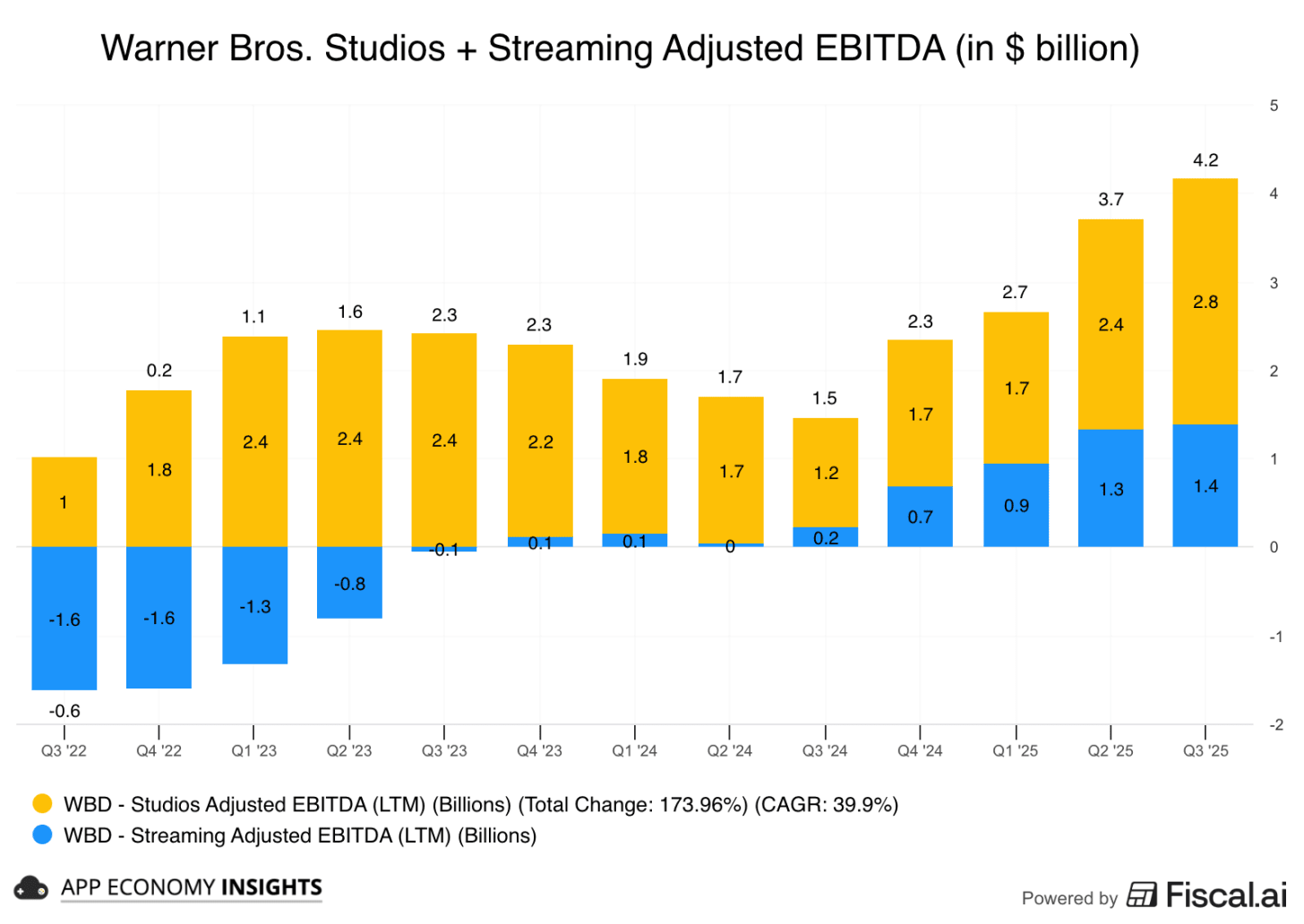
At an enterprise value of ~$83 billion, Netflix is essentially paying ~20x EBITDA. It gets to 25x if we use Warner’s expected EBITDA of $3.3 billion for FY26. That’s a big premium for a no-growth business, as you would expect after a bidding war. For perspective, Disney is currently trading at ~12x EBITDA.
Critically, Netflix expects $2-to-3 billion in annual cost savings by year 3. If they can deliver on the high end of this goal, the valuation comes down to ~12x EBITDA and makes more sense.
In addition, there is a wide range of value that could be unlocked and not reflected in trailing financial metrics:
Netflix IPs get a publishing and distribution boost via vertical integration (potential theatrical releases, licensing, gaming).
Warner Bros. IPs get to reach over 300 million Netflix members, potentially unlocking a new fanbase for century-old franchises, fueling the rest of the flywheel (more on this in a minute).
Netflix agreed to a massive $5.8 billion termination fee.
What this means: If regulators (DOJ/FTC) block the deal, Netflix must pay WBD $5.8 billion just for walking away.
The signal: This is one of the largest breakup fees in M&A history. Netflix is putting 8% of the deal’s equity value on the line (much higher than the typical 2% to 3% seen on other large deals), showing confidence they can get it done and convince regulators.
Meanwhile, if WBD shareholders vote down the deal or Warner takes a rival offer, there is a $2.8 billion reverse breakup fee. If Paramount makes another bid, it would be on the hook for that fee, making it less likely.
2025-12-06 23:00:57
Welcome to the Saturday PRO edition of How They Make Money.
Over 250,000 subscribers turn to us for business and investment insights.
In case you missed it:
📊 Monthly reports: 200+ companies visualized.
📩 Tuesday articles: Exclusive deep dives and insights.
📚 Access to our archive: Hundreds of business breakdowns.
📩 Saturday PRO reports: Timely insights on the latest earnings.
Today at a glance:
❄️ Snowflake: RPO Surge
🖥️ HPE: Networking Pivot
🔐 Okta: AI Identity in Focus
🌐 Samsara: Profitable Scale
✍️ DocuSign: IAM Acceleration
🔷 Rubrik: Cyber Resilience Breakout
🏥 HealthEquity: Assets Swell
🤖 UiPath: Agentic Surge
👁️ SentinelOne: AI Traction & CFO Exit
📝 Asana: AI Teammates Arrive
🧠 C3.ai: Stabilization Signs
Snowflake’s Q3 revenue rose 29% Y/Y to $1.21 billion ($30 million beat), and non-GAAP EPS was $0.35 ($0.04 beat). Product revenue grew 29% to $1.16 billion, and Net revenue retention held steady sequentially at a best-of-breed 125% (only second to Palantir in public markets).
Remaining performance obligations (RPO) surged 37% Y/Y to $7.9 billion (an acceleration from 33% Y/Y in Q2), indicating large customer wins.
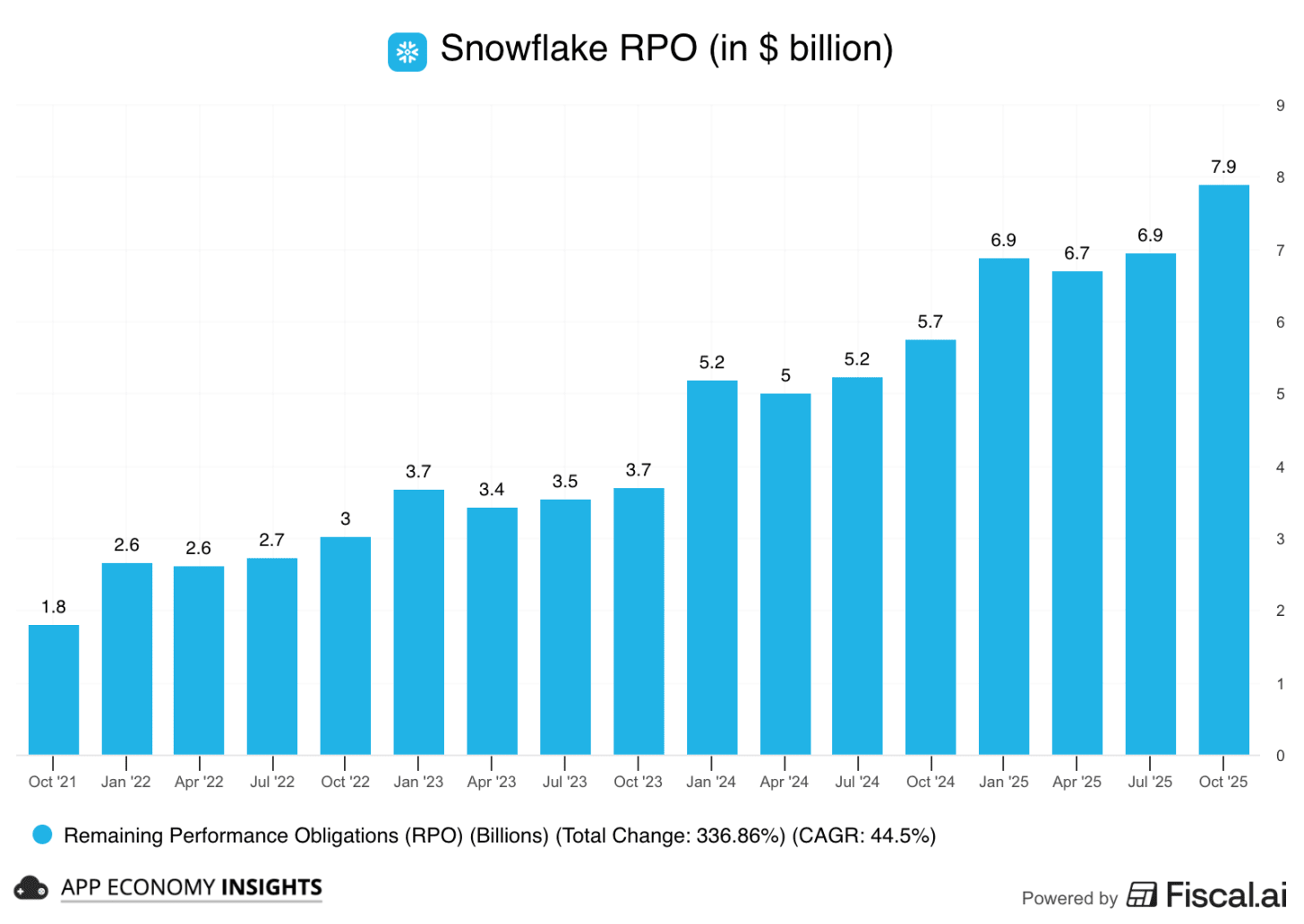
Adjusted operating margin expanded to 11% (from 6% a year ago). On a GAAP basis, it remains ugly with an operating loss margin of -27%, though it improved significantly from -39% a year ago. The main difference is stock-based compensation, which remained huge at 34% of revenue.
Large customer momentum was a standout. Snowflake signed a record four nine-figure deals in the quarter. Customers generating over $1M in product revenue grew 29% Y/Y to 688, and the company’s total customers rose 20% Y/Y to 12,261 (both metrics accelerating).
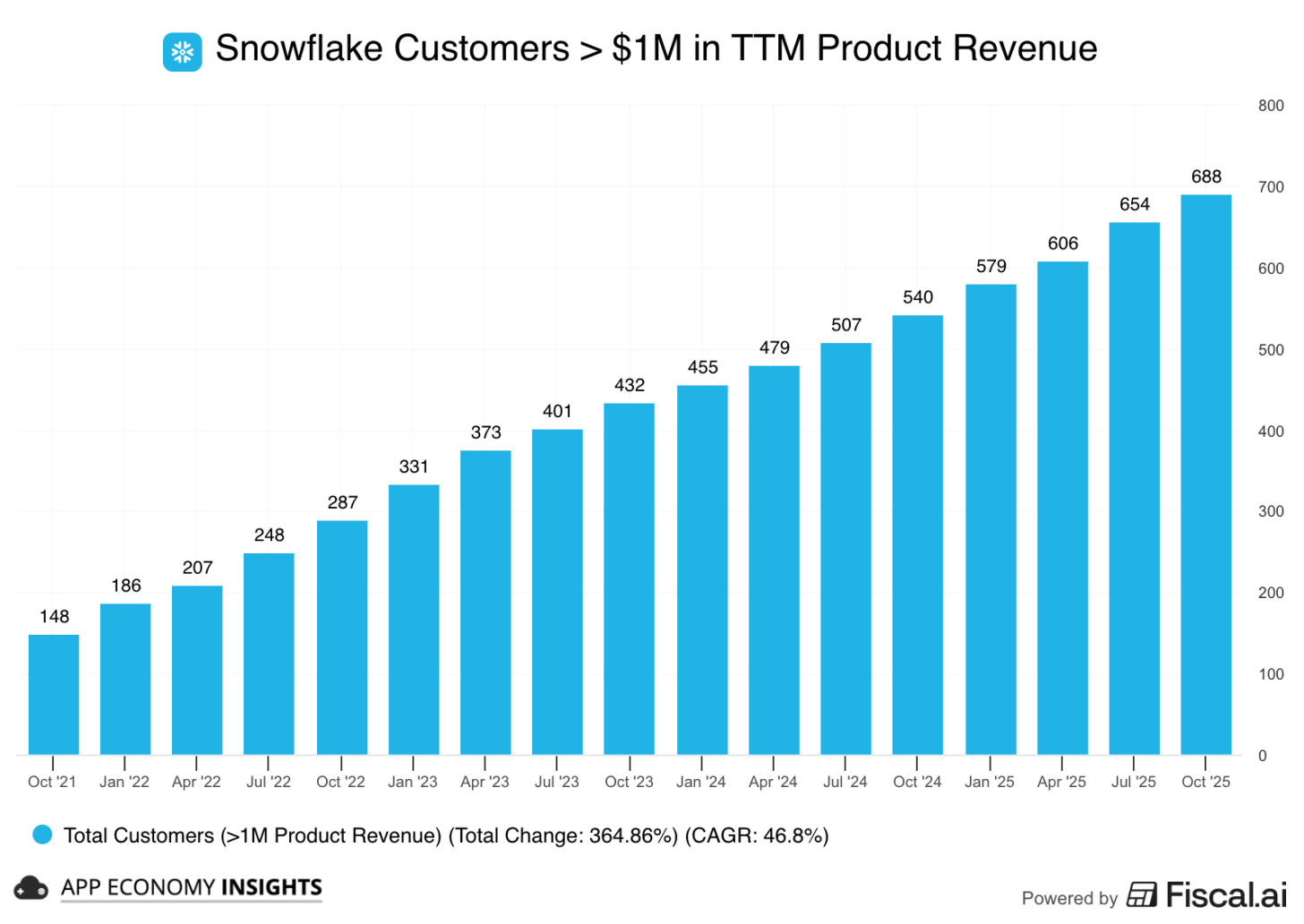
Management raised the full-year FY26 product revenue guidance by $41 million to ~$4.45 billion. However, shares fell as the Q4 operating margin guide of 7% missed consensus, implying a significant margin compression with continued AI investment.
CEO Sridhar Ramaswamy highlighted that Snowflake hit a $100 million AI revenue run rate one quarter ahead of schedule. To be sure, this is still a tiny portion of overall revenue at this stage.
Snowflake Intelligence (agentic AI) is seeing the fastest adoption ramp in company history. To bolster this, Snowflake announced a $200 million partnership with Anthropic to bring Claude models to the platform. While the margin outlook for Q4 is concerning, the acceleration in RPO and tangible AI monetization suggests the product strategy is delivering results.
2025-12-05 21:01:34
Welcome to the Free edition of How They Make Money.
Over 250,000 subscribers turn to us for business and investment insights.
In case you missed it:
Zuck is finally listening. After burning nearly $70 billion on Reality Labs since 2021, Meta is reportedly preparing to slash its Metaverse budget by up to 30%.
The stock jumped on the news. Wall Street sees this as a signal of discipline and focus. Call it the “Year of Efficiency” part deux. Reality Labs’ losses have been an overhang for years, while the core “Family of Apps” business has been thriving.
The company isn’t exiting hardware altogether. Instead, it is a surgical strike on the software that powers the Metaverse vision.
Target: The cuts will reportedly hit Meta Horizon Worlds (the virtual social platform) and the VR unit (Quest) most heavily.
Timeline: Layoffs could happen as early as January as part of the 2026 budget planning cycle.
Meta spent billions on a platform war that no one else showed up to fight. With adoption still stuck in the gaming niche and rivals like Apple and Google pivoting entirely to AI and Spatial Computing, the “existential threat” has vanished. Zuck is realizing he is effectively racing against himself, which means he has the luxury to slow down.
To be sure, Zuck still has hardware on his mind. He just poached Alan Dye, Apple’s longtime VP of Human Interface Design, who will lead a new Creative Studio at Reality Labs. Dye led the design for the Apple Watch and Vision Pro interfaces. His move suggests Meta is now serious about building hardware that people actually want to wear.

Reality Labs has been described as a “leaky bucket” by analysts. By capping the Metaverse spend, Zuckerberg can reallocate capital to the real war: Generative AI and Smart Glasses (the hardware that actually has traction).
If you recall, Meta and EssilorLuxottica have sold over 2 million pairs of Ray-Ban Meta AI since their launch in October 2023. The company is on track to raise production to 10 million units per year by the end of 2026 to meet demand.
Zuck has already dropped hints that the “Family of Apps vs. Reality Labs” reporting structure is becoming obsolete.
“Over time, we’ll probably need to find better ways to articulate the value that’s being generated here across both segments so it doesn’t just seem like our hardware costs increase as our glasses ecosystem scales, but all the value flows to a different segment.”
Expect a potential re-segmentation in FY26 that blurs these lines—and conveniently hides the standalone “Metaverse” losses inside a broader “AI Infrastructure” cost center.
Takeaway: In late 2021, Facebook changed its name to Meta to signal the future. In 2025, the budget cuts signal the reality. By shrinking the Metaverse ambitions, Zuck is admitting that while the vision remains, the timeline was wrong. Meta is now effectively an AI company that also sells headsets. And investors are thrilled.
Marvell’s Q3 FY26 (October quarter) was all about the pivot to AI infrastructure. The company has effectively transformed from a cyclical semiconductor maker into a pure-play AI bet.
You might notice a massive $1.9 billion windfall in “other income” in the top right. This is a one-time gain from the sale of Marvell’s Automotive Ethernet business to Infineon during the quarter. While it boosted the bottom line significantly, it is a non-recurring event, which also explains why the Automotive/Industrial revenue segment dropped sharply year-over-year.
Overall revenue rose 37% Y/Y to $2.1 billion ($10 million beat), and non-GAAP EPS jumped 77% Y/Y to $0.76 ($0.02 beat). Data Center revenue surged 38% to $1.52 billion, accounting for 73% of total revenue. While Enterprise and Carrier rebounded, it was from a very low base.
In just two years, Data Center revenue has nearly tripled from ~$500 million to ~$1.5 billion, effectively offsetting the cyclical decline in the other segments

Margins improved dramatically following a restructuring last year, and operating cash flow improved 9% Y/Y to $582 million. Management leaned into capital returns with $1.3 billion of buybacks plus dividends.
The headline move is the $3.25 billion acquisition of Celestial AI.
The problem: As GPU clusters grow to 100k+ units, copper wires struggle to move data fast enough without overheating the rack.
The solution: Celestial’s “Photonic Fabric” uses light to transfer data. Their first chiplet delivers 16 Tb/s of bandwidth, unlocking the next generation of scale-up architecture.
Deal Structure:
Upfront: $1 billion cash + $2.25 billion in stock.
Earnout: Up to $2.25 billion in additional stock if revenue milestones are hit (at least $500 million cumulative by FY29 or more, with full earnout at $2+ billion).
Target: Management expects an annualized run rate of $500 million by Q4 FY28.
The near-term guide was in line, but the multi-year outlook moved the stock.
FY26: Data center revenue expected to grow >25% (excluding Celestial).
FY27: Targeting ~40% growth, driven by custom silicon and the photonic ramp.
Why the confidence? Custom silicon remains the core engine. Marvell expects sales to grow ~20% next year with no “air pockets.” Analysts now see stronger visibility into programs tied to Amazon’s Trainium, Microsoft’s Maia, and a new win with an “emerging hyperscaler.”
Takeaway: Marvell is betting that the bottleneck in AI is not just compute, but connectivity. By acquiring Celestial AI, they are securing the transition from electrical (copper) to optical (light) interconnects. Execution risk is real, and the Celestial payoff is years away. But if they hit their targets, Marvell becomes the indispensable glue holding the AI data center together.
Salesforce posted a solid but unspectacular quarter on the surface, but under the hood, the engine is shifting gears. Revenue grew 9% Y/Y to $10.3 billion (in-line), and non-GAAP EPS landed at $3.25 ($0.39 beat).
The margin expansion story continued, with the operating margin improving to 21% (+1pp Y/Y). Importantly, the business remains a cash machine, with free cash flow growing 22% to $2.2 billion.
The real story this quarter is the definitive pivot from experimentation to paid production. Marc Benioff called Agentforce and Data 360 the “momentum drivers,” and the paid deal velocity backs him up.
The combined ARR for these products hit ~$1.4 billion, more than doubling year-over-year (+114%). Agentforce alone has surged to a $540 million run-rate, growing an explosive 330% Y/Y. Of course, that’s a tiny piece of Salesforce’s ~$41 billion revenue expected in FY26, but the momentum is critical here.
Context: Salesforce revealed a $440 million Agentic AI ARR in Q2 during its Investor Day. The climb to $540 million implies a ~23% sequential growth.
Real signal: The most impressive metric is the deal volume. They closed 9,500+ paid Agentforce deals in Q3, a massive 58% jump from the 6,000 paid deals reported in Q2. And the platform processed a staggering 3.2 trillion tokens.
This is the “Agentic Enterprise” in action: moving from sidecar chatbots to autonomous agents embedded directly into sales and service workflows. Crucially, half of these bookings came from existing customers expanding their footprint, a classic signal of platform durability.
Benioff used the call to dismantle the “DIY AI” narrative, noting that companies trying to build their own agents (like Klarna in late 2024) are hitting a wall on security and governance—driving them back to software platforms.
Salesforce is quietly solving the last-mile problem of AI: getting clean, harmonized data into agentic workflows.
The acquisition of Informatica (closed ahead of schedule in November), combined with Data 360, creates a data layer that management expects to become a $10 billion business next year.
The goal is to ingest tens of trillions of records to power low-hallucination agents across verticals like Life Sciences and Public Sector.
Management nudged the full-year outlook higher, but that was all due to Informatica closing earlier than expected, contributing roughly $330 million.
Q4 revenue: $11.2 billion (+12% on the high-end).
FY26 revenue was raised by $0.3 billion to $41.5 billion, matching the Informatica contribution.
Current RPO is expected to accelerate to ~13% growth in constant currency in Q4 (boosted by Informatica), and remains the best indicator for future revenue growth.
While organic growth is still single digits (~9%), management explicitly signaled a 12–18 month path to re-acceleration as Agentforce scales and the data stack fully integrates.
Takeaway: Salesforce sits in the middle of the AI bifurcation. It is a mature incumbent under valuation pressure (down nearly 30% this year), but the rapid growth of Agentforce offers a path out. By turning into the orchestration layer for agentic workflows, Salesforce is showing the first tangible signs of shifting from “AI victim” toward “AI enabler.” The clock is ticking, but the pivot is real.
That’s it for today.
Happy investing!
Thanks to Fiscal.ai for being our official data partner. Create your own charts and pull key metrics from 50,000+ companies directly on Fiscal.ai. Start an account for free and save 15% on paid plans with this link.
Disclosure: I own CRM and META in App Economy Portfolio. I share my ratings (BUY, SELL, or HOLD) with App Economy Portfolio members.
2025-12-03 09:14:44
Welcome to the Premium edition of How They Make Money.
Over 250,000 subscribers turn to us for business and investment insights.
In case you missed it:
Google’s TPUs and NVIDIA’s GPUs are dominating the conversation.
But remember, AI is a stack:
📱 Apps: User-facing tools like ChatGPT, Shopify, and Copilot.
☁️ Cloud: The developer platforms and infrastructure underneath.
⚡️ Silicon: The compute hardware powering everything at the bottom.
And the real story this earnings week is happening above the chips.
We are seeing a historic bifurcation in the sector:
AI victims like Adobe are trading at their lowest valuation multiples in a decade (20x earnings) as investors fear generative AI will cannibalize their seat-based pricing.
AI enablers like Palantir are commanding premiums not seen since 2021 (over 100x revenue).
Three companies just reported results that hint at where this cycle is heading next.
I’m talking about the databases, security layers, and operations pipelines where AI workloads actually run.
And the patterns are worth a closer look.
Today at a glance:
🌱 MongoDB: Breakout Momentum.
🦅 CrowdStrike: AI Adoption Rises.
🛠️ GitLab: The Copilot Reality Check.
Disclosure: MDB, CRWD, and GTLB are holdings in App Economy Portfolio.
FROM OUR PARTNERS
Probably, yes.
The IRS sets 2025 Roth IRA income limits: $150k-$165k (single) and $236k-$246k (married).
With backdoor conversions, these limits disappear, unlocking tax-free growth. For high earning households, this strategy is essential for long-term wealth building.
Range helps optimize your backdoor Roth timing and implementation.
Book your free demo with Range to learn how to take advantage of this strategy as well as more to maximize your wealth.
Disclosure: Not investment advice. Visit www.range.com for details.
MongoDB delivered another standout quarter, with the stock jumping over 22% after earnings. Revenue grew 19% Y/Y to $628 million ($35 million beat), and non-GAAP EPS hit $1.32 ($0.53 beat).
Gross margin has been compressing as the revenue mix shifts toward cloud consumption. On the bright side, stock-based compensation was nearly flat Y/Y, helping push the operating margin close to breakeven. Free cash flow hit $140 million, a 4× increase from last year.
The highlight: Developer data platform Atlas accelerated to 30% Y/Y, its fastest pace in six quarters (up from 29% Y/Y in Q2). Atlas now represents 75% of revenue, up from 68% a year ago, driven by strong enterprise demand, healthy developer adoption, and broad-based strength across geographies.
Net ARR expansion: 120% (up from 119% in Q2).
Total customers: +17% Y/Y to 62,500+ (accelerating from 16% Y/Y in Q2).
$100K+ ARR customers: +16% Y/Y to 2,694.
Existing customers are expanding, new logos remain steady, and the go-to-market engine continues to hum.

Management lifted both Q4 and full-year expectations:
Q4 revenue: $665–$670 million (+22% Y/Y, and a $42 million beat).
FY26 revenue: $2.44 billion ($87 million raise in the mid-range)
FY26 EPS: $4.78 ($1.09 raise in the mid-range).
Atlas is expected to grow 27% next quarter, with non-Atlas in the upper single digits. Free cash flow conversion should exceed 100% for the year.
The magnitude of the FY26 raise caught the market off guard. MongoDB already raised FY26 revenue guidance by $80 million in Q2, but this second upward revision (with only one quarter left) signals real momentum. Earlier in the year, management missed Wall Street’s expectations by $70 million when setting FY26 guidance. It’s now clear that it was simply a conservative setup rather than weakening fundamentals.
New CEO CJ Desai (formerly President & COO at ServiceNow and President of Product and Engineering at Cloudflare) is pitching a clear vision. MongoDB is the modern data platform for AI.
The memory advantage: AI agents require “long-term memory” to function effectively. MongoDB’s document model naturally fits this unstructured data better than rigid SQL tables.
Vector leadership: Their Vector Search ranked #1 on Hugging Face benchmarks, signaling they can compete with niche vector databases on performance.
Hybrid power: Key AI features are now available on-prem, allowing regulated industries to build AI applications without data ever leaving their secure environment.
MongoDB’s unified document model, combined with search and vector architecture, is becoming a compelling foundation for AI workloads.
Takeaway: The slowdown fears from early 2025 are officially dead. Under new leadership, MongoDB has delivered accelerating cloud growth, rising profitability, and early momentum in AI workloads. With Atlas back at 30% growth and guidance moving higher, the company has successfully positioned itself as the “memory layer” of the AI stack.
If there were any lingering doubts about CrowdStrike’s post-outage recovery, Q3 put them firmly in the rearview mirror. Revenue grew 22% Y/Y to $1.23 billion ($10 million beat), and non-GAAP EPS landed at $0.96 ($0.02 beat). Margin stayed relatively flat, with free cash flow margin at 24%.
2025-11-29 23:02:20
Welcome to the Saturday PRO edition of How They Make Money.
Over 250,000 subscribers turn to us for business and investment insights.
In case you missed it:
📊 Monthly reports: 200+ companies visualized.
📩 Tuesday articles: Exclusive deep dives and insights.
📚 Access to our archive: Hundreds of business breakdowns.
📩 Saturday PRO reports: Timely insights on the latest earnings.
Today at a glance:
🇨🇳 Alibaba: Cloud Pops While Profit Drops
👷 Home Depot: Macro Slowdown
⚙️ Analog Devices: Cyclical Recovery
👔 Workday: AI ARR Accelerates
💻 Dell: AI Server Orders Hit Record
☁️ Zscaler: AI Security Explodes
🖥️ Zoom: AI Platform Transition
🖨️ HP: Job Cuts & Soft Guidance
🏗️ Autodesk: AECO Dominance
☁️ Nutanix: Revenue Timing Slips
⚡️ NIO: Margin Rebound
🛒 Best Buy: Marketplace Accelerates
FROM OUR PARTNERS
Fiscal.ai is my favorite place to research new stock ideas from scratch.
Unlimited data on 100k companies.
Compare companies head-to-head.
Manage watchlists and dashboards.
Largest segment & KPI database in the world (2,300+ stocks).
They only run two sales per year, so you won’t want to miss this!
Fiscal.ai is our data partner, so our readers already get 15% off their paid plans. And this Cyber Week, you get an even larger discount of 30% off all their paid plans!
But don’t wait! The discount is only valid until Monday.
The 30% discount will be automatically applied at checkout.
Alibaba’s Q2 revenue rose 5% Y/Y to $34.8 billion ($570 million beat). Excluding disposed businesses, like-for-like revenue growth was 15% Y/Y. However, the company missed earnings estimates, and non-GAAP net income fell 71% Y/Y. This plunge was driven by aggressive spending on quick commerce subsidies and user experience. Sales & marketing expenses rose from 14% to 27% of revenue.
The core story is now divided into two accelerating segments:
Cloud Intelligence Group: Revenue grew 34% Y/Y (accelerating from 26% in Q1). AI-related product revenue posted its ninth consecutive quarter of triple-digit growth and now represents over 20% of external cloud revenue.
China e-commerce: Revenue grew 16% Y/Y. Customer Management Revenue (CMR) grew 10%, supported by improving unit economics in the quick commerce business, which saw its loss per order reduced by 50% sequentially.
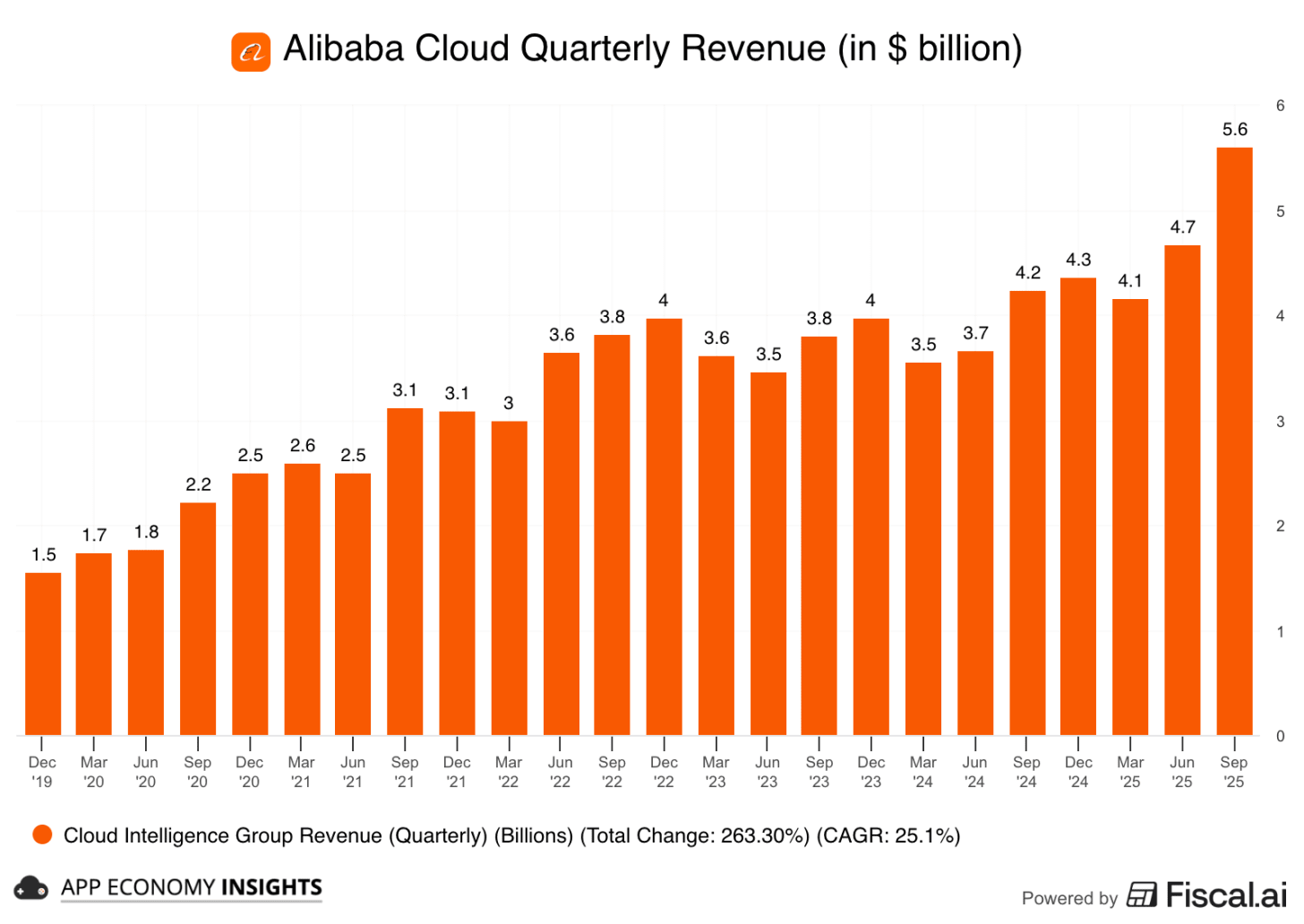
Management stated it has entered an “investment phase” to build long-term value in AI and consumption platforms, noting that current AI infrastructure demand is outstripping supply (sounds familiar?). The quick commerce investment is expected to have peaked in the September quarter, and the company will continue to sacrifice short-term profits for long-term strategic growth. Alibaba’s Qwen AI app also gained over 10 million users in its first week of public beta, an encouraging move into consumer AI.
Home Depot just dropped its 10-Q earlier this week. Q3 revenue rose 3% Y/Y to $41.3 billion ($230 million beat), primarily due to the acquisition of GMS in October, contributing ~$0.9 billion in sales. Non-GAAP EPS was $3.74 (a $0.09 miss).
Comparable sales grew only 0.2% (missing the expected 1.4% growth), with US comps up a modest 0.1%. Transactions declined 1.6%, offset by a 1.8% rise in the average ticket.
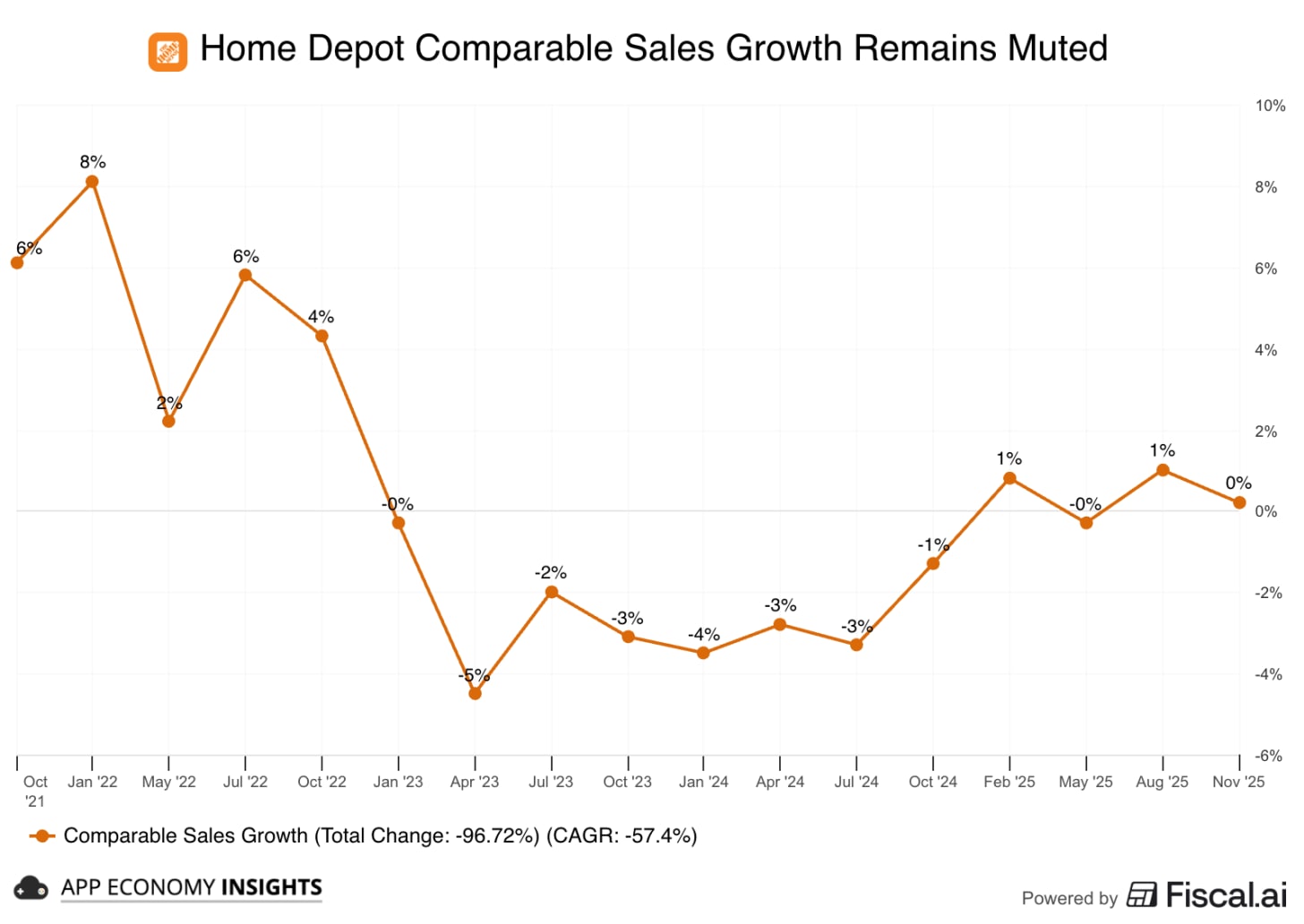
The miss was attributed to two main factors: a lack of storm activity (which usually boosts certain repair categories) and continued weakness from consumer uncertainty and housing market pressure that is disproportionately impacting large, financed remodels.
Management cut its full-year FY25 adjusted EPS guidance (now expected to decline 5% Y/Y, worse than the prior 2% decline), while slightly raising the revenue target (now roughly $3% growth) due to the inclusion of the GMS sales. The outlook remains cautious, as the company sees no near-term catalyst for an acceleration in big-ticket demand, focusing instead on pro customer momentum and the long-term fundamentals.
2025-11-28 21:03:16
Welcome to the Free edition of How They Make Money.
Over 250,000 subscribers turn to us for business and investment insights.
In case you missed it:
FROM OUR PARTNERS
Fiscal.ai now powers my charts and financial data.
It’s my favorite place to research new stock ideas and visualize their performance:
Screeners.
Chart builder.
Portfolio tracker.
Earnings materials.
Side-by-side comparisons.
Quick fundamentals overlays.
You can select a specific company revenue segment or KPI and compare it across multiple companies. Your imagination is the only limiting factor!
Fiscal.ai is our data partner, so our readers already get 15% off their paid plans. And this Black Friday, you get an even larger discount of 30% off all their paid plans!
But don’t wait! The discount is only valid until Cyber Monday.
Abbott Laboratories is a $220 billion medical device giant. But the company is far more than devices. Abbott also generates billions from diagnostics, nutrition, and established pharmaceuticals, making it one of the most diversified healthcare companies in the world.
Now Abbott is acquiring Exact Sciences, the maker of the blockbuster Cologuard colorectal cancer screening test, in a $21 billion all-cash deal expected to close in Q2 2026. The acquisition says a lot about where the diagnostics segment is headed.
Exact Sciences isn’t a typical bolt-on. Cologuard has become one of the most successful at-home diagnostic products ever, generating over $2 billion annually, growing double digits, and backed by one of healthcare’s most reliable recurring revenue streams: screening compliance.
For Abbott, this adds a sticky, high-margin diagnostics business with huge cross-sell potential. As CEO Robert Ford put it: “Our vision here is really to build the premier cancer diagnostics company in the world.”
Cologuard thrives because of provider relationships, patient awareness, and ease of use. Abbott excels at all three.
Abbott can push Cologuard through its global distribution, bundle it with existing diagnostics, and potentially replicate the model across other cancer-screening categories Exact has been developing. It’s the same playbook that turned FreeStyle Libre into a category-defining product.
Cancer screening is recurring. Diagnostics are predictable. Cologuard has brand recognition that most tests never achieve. And Abbott has the balance sheet and sales force to scale it globally.
Exact Sciences is projected to generate more than $3 billion in revenue this year, which will push Abbott’s diagnostics revenue above $12 billion annually once the deal closes.
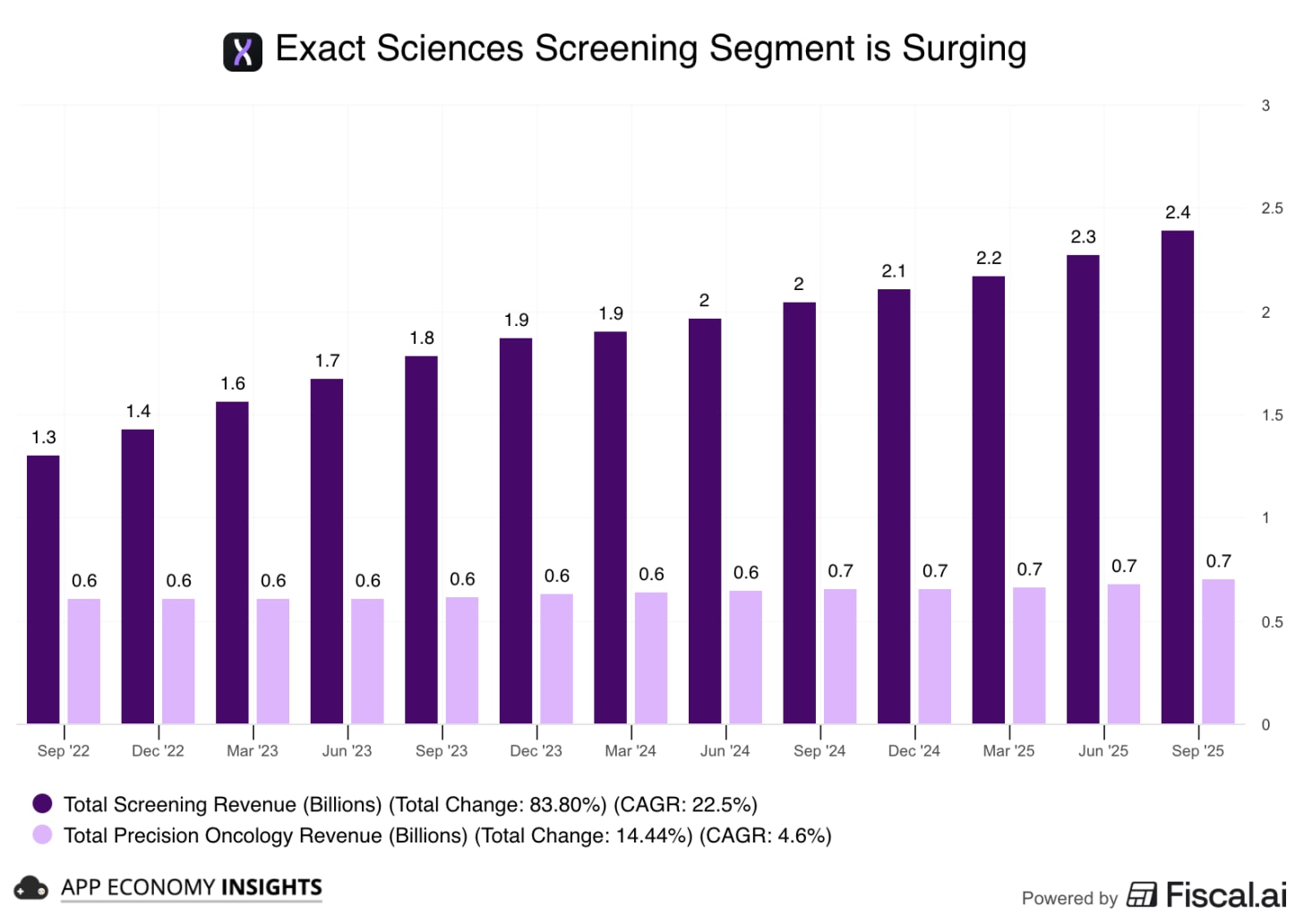
Here’s what Exact’s margin profile looks like. The dramatic dip in Q4 FY24 came from large one-time charges, impairment write-downs, and restructuring costs. Gross margins stayed steady, and operating margin quickly rebounded, confirming the core business was intact.
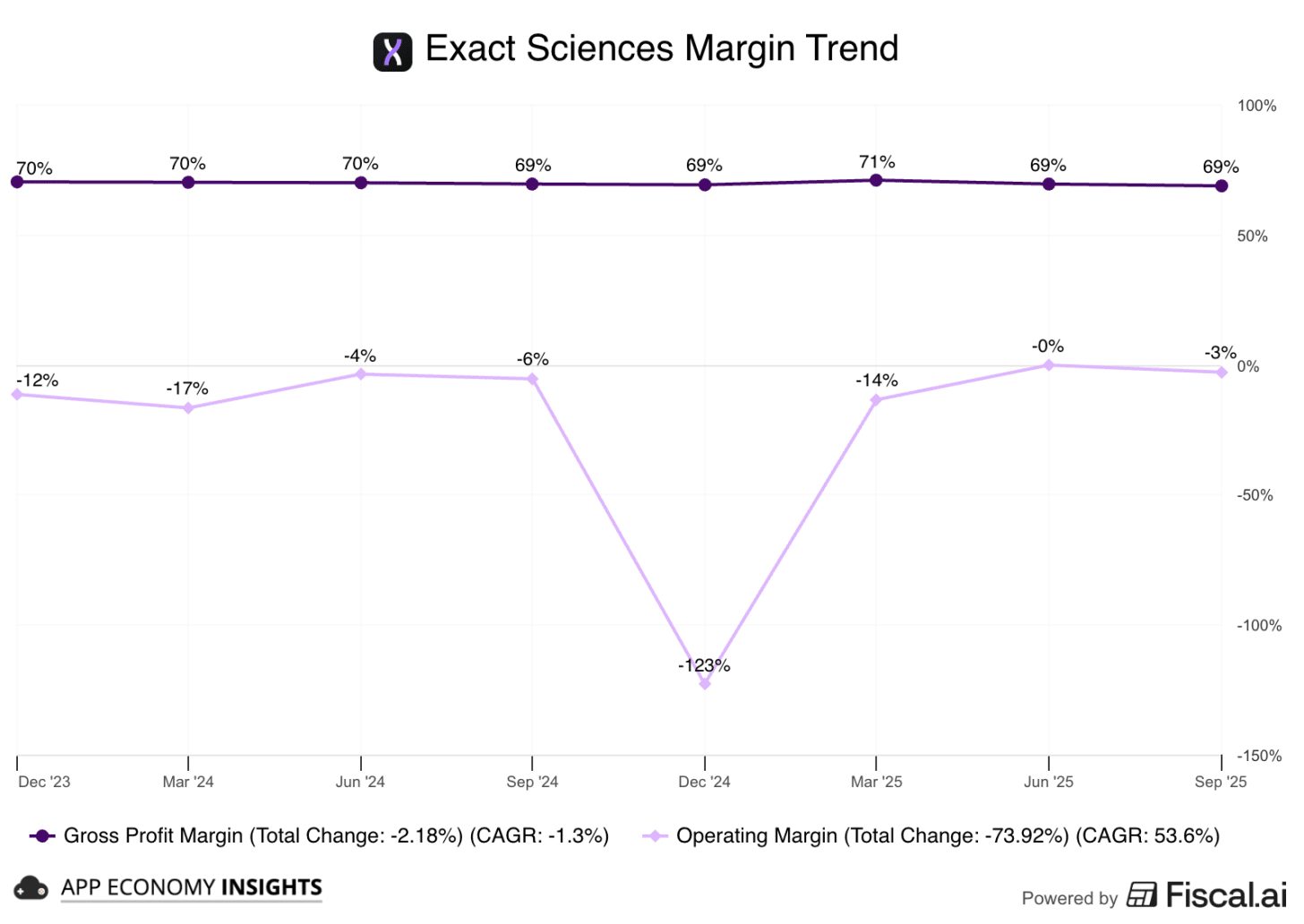
This deal fits a broader trend of healthcare incumbents buying proven products with reliable, repeatable demand rather than funding moonshot R&D from scratch.
Recent examples include:
Johnson & Johnson acquiring Shockwave Medical (~$13 billion) for high-growth cardiovascular devices.
Danaher acquiring Abcam (~$6 billion) to strengthen its antibody and reagent portfolio.
Thermo Fisher buying Olink (~$3 billion) to expand proteomics and biomarker capabilities.
In uncertain markets, incumbents buy certainty instead of chasing moonshots. Abbott itself has the balance sheet capacity for up to $30 billion in debt-funded M&A, thanks to low leverage and $7 billion in annual free cash flow.
AI skepticism has resurfaced in a big way. So much so that Michael Burry of “Big Short” fame launched a paid Substack arguing that NVIDIA is the new Cisco, or that US Big Tech is engaged in accounting fraud. Both are highly questionable claims, but they capture the moment.
As massive AI infrastructure commitments circulate through the market, including OpenAI’s multi‑year buildout, investors must answer a simple question: Who is actually on the hook for delivering all this compute? And how much of that future demand is already baked into today’s stock prices?
Public companies exposed to the AI supercycle are now being repriced based on execution risk. After all, if a stock surged on inflated expectations, the risk of a round trip is real.
A popular chart making the rounds on X this week was the stock price performance of the Google universe (including GOOG and AVGO due to Broadcom’s role in manufacturing Google’s TPU chips) compared to the OpenAI universe (NVDA, AMD, ORCL, MSFT, and CRVW benefiting from demand from the AI startup). The market keeps repricing based on the latest information available.
Oracle has been at the center of the biggest AI story of the year: OpenAI’s $1.4 trillion multi-year commitments. Few companies have tied their future to that wave as aggressively as Oracle.
Oracle’s latest quarter showed a stunning $455 billion in remaining performance obligations (RPO). Management tied hundreds of billions of that to long-term AI cloud deals, with OpenAI front and center.
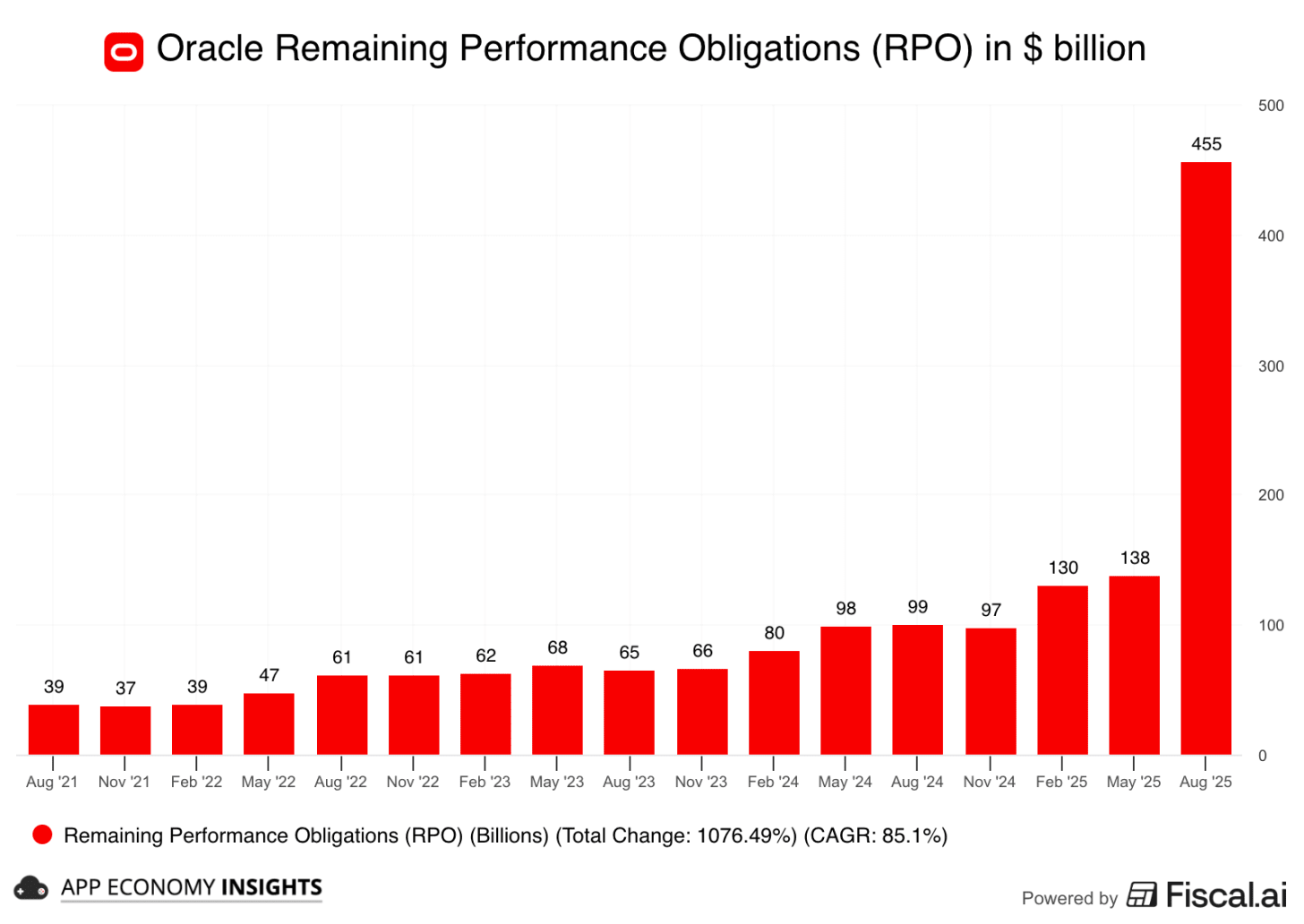
But here’s the nuance:
RPO is not cash.
RPO is not revenue.
RPO is not even demand.
It’s a mix of multi-year capacity agreements, partial non-cancellable commitments, and cloud reservations that reflect intent rather than realized consumption.
Oracle’s stock price doubled from January to September, driven by the sheer scale of these AI commitments. Now the stock has fallen back to earth (down more than 40% in the past two months) as the market questions how much of this will convert, and how quickly.
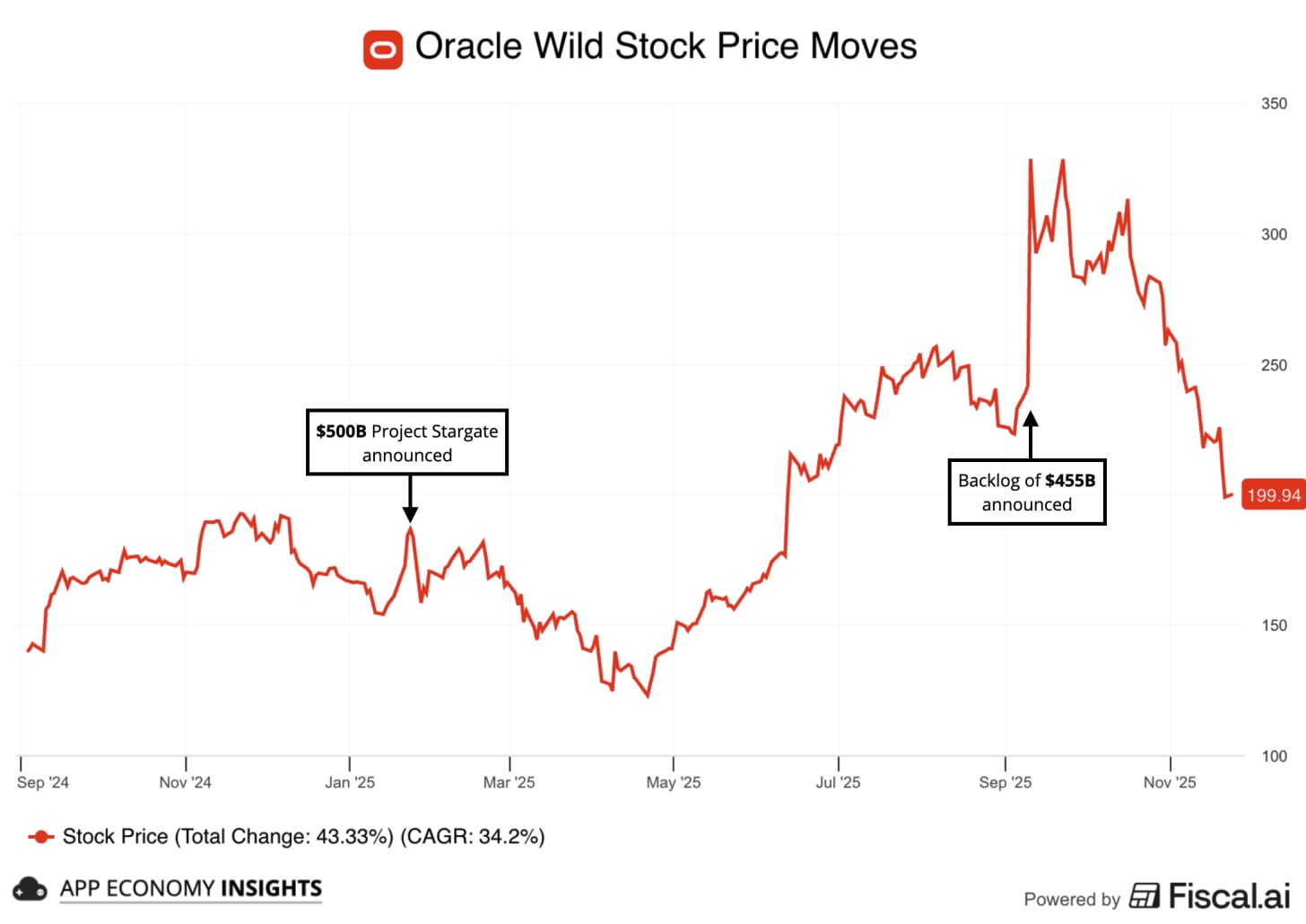
The massive backlog announcement came from Project Stargate, which was already well documented. You could argue the stock rally was never justified to begin with, since the size of the contract was already well known. But what matters now is that the market shaved off the entire spike, and then some.
In short, skepticism is reflected in the stock price.
Oracle is not like the rest of Big Tech. It’s investing ahead of hypothetical revenue. Unlike hyperscalers with massive existing free cash flow funding their AI buildouts, Oracle is leveraging up to finance a rapid global expansion of data centers.
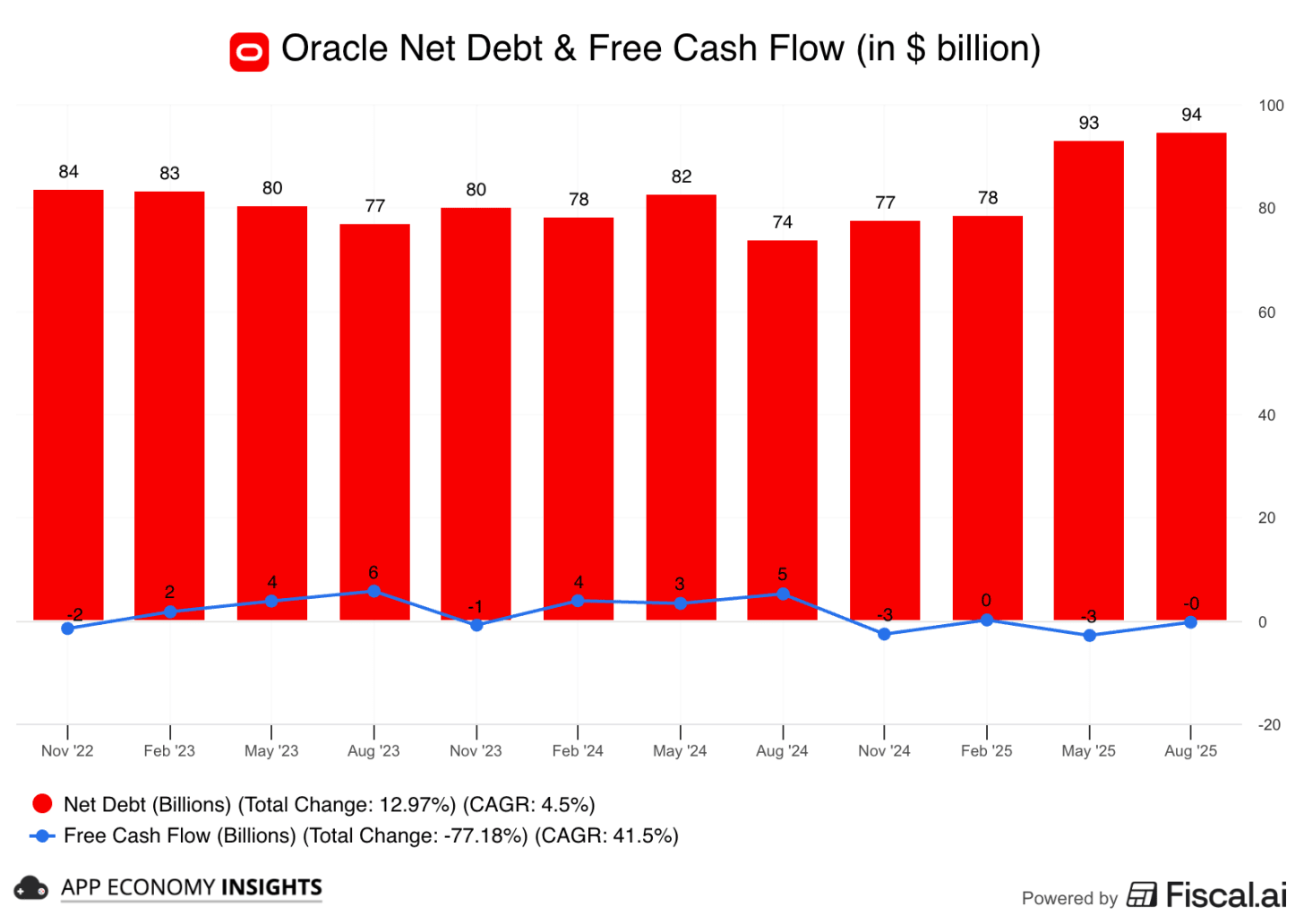
Key pressures include:
Higher debt levels.
Capex rising faster than cash flow.
Tight financial flexibility compared to peers.
This works brilliantly if everything clicks, but it creates a real downside if it doesn’t.
Microsoft, Amazon, Google, and Meta are funding AI infrastructure from strong balance sheets and operating cash flow. Demand is diversified across existing product lines like ad performance, enterprise cloud spend, government workloads, and SMB adoption.
Below is a 30,000-foot view of their annual free cash flow in the past decade, with the 2025 data as of September (trailing 12 months). And remember, free cash flow is already net of CapEx, so the impact of the so-called runaway spending is already baked into these numbers.
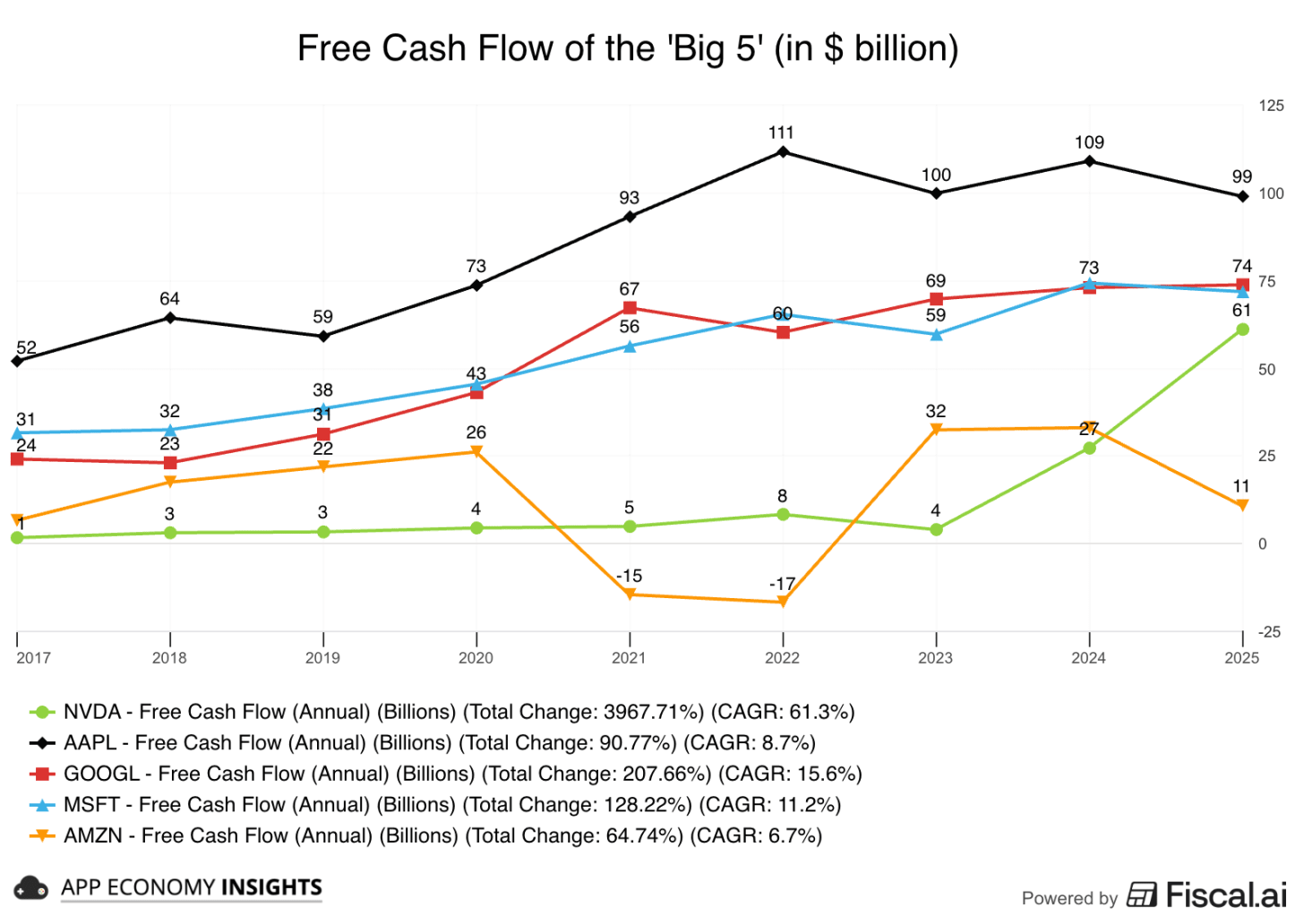
Their valuation is anchored on existing cash flow, not a hypothetical future. Amazon is an outlier in the chart above because the company is in perpetual ‘Day 1’ mode, reinvesting operating cash flow in new initiatives like Project Kuiper (low-earth satellites).
Could AWS, Azure, and Google Cloud see softer demand at some point if large AI startups fail to find product-market fit? Possibly. But if you are a regular reader of our earnings breakdowns, you know that many Enterprise customers are already seeing meaningful revenue growth from AI features. On the consumer side, Google and Meta have improved their products with AI (engagement, ad conversion), boosting revenue growth and margins.
Oracle, by contrast, has:
The biggest explicit AI-startup-related backlog.
The least balance sheet and cash flow flexibility.
The highest sensitivity to any slowdown in AI demand.
That’s why the market is going to treat AI exposure with different levels of scrutiny.
The AI supercycle is real. But when it comes to what’s priced in, investors are now focused on execution. Oracle’s latest round trip shows that the market has already adjusted some valuations, giving a premium to tangible earnings growth and looking at hypothetical long-term upside with caution.
And you know what? For a market that’s been deemed frothy for a while, a healthy sell-off in inflated stocks is just what the doctor ordered.
That’s it for today.
Happy investing!
Thanks to Fiscal.ai for being our official data partner. Create your own charts and pull key metrics from 50,000+ companies directly on Fiscal.ai. Start an account for free and save 30% on paid plans this Black Friday with this link.
Disclosure: I own AAPL, AMD, GOOG, AMZN, META, and NVDA in App Economy Portfolio. I share my ratings (BUY, SELL, or HOLD) with App Economy Portfolio members.